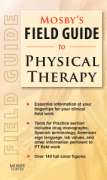
Mosby's field guide to physical therapy
Ideal for clinical settings, this unique, handheld reference provides the most vital details of assessment diagnosis and treatment in a portable, lay-flat format. The convenient organization with color-coded sections and information broken down into charts, tables, and lists makes it easy to find information quickly. With content compiled, created and reviewed by experts in PT practice and education, you'll have all of the information you depend on for academic and clinical success in one convenient reference! INDICE: SECTION ONE: ANATOMY Anatomy AtlasBonesMusclesOrgans and Other Anatomical FeaturesMuscle Origin, Insertion, and InnervationAnatomical Directional TermsCranial Nerve FunctionSECTION TWO: EXAMINATIONExamination/Evaluation SequenceHistory and Review of Systems Physical ExamSample Upper Quarter Examination Sequence Sample Lower Quarter Examination Sequence Tests and MeasuresTestsand Measures Used in the Physical Therapy ExaminationPediatric Physical Therapy Assessments Sample List of Examination Tools Example of an Assessment Form Posture Assessment Anatomical position. Faulty postures: Kyphosis-lordosis, swayback, and flatback compared with ideal alignment. Joint Range of Motion and Muscle Length TestingProcedures for Measuring Joint Range of Motion and MuscleLength Suggested Values for Normal ROM for Joints of the Upper and Lower Extremity in Adults Based on Analysis of Existing Data Traditionally Quoted Valuesfor Normal ROM for Joints of the Upper and Lower Extremity in Adults Traditionally Quoted Values for Normal ROM of the Thoracic and Lumbar Spine in Adults Suggested Values for Normal ROM of the Thoracic and Lumbar Spine in Adults Suggested Values for Normal ROM of Cervical Spine in Adults Muscle Test Grades Example of a Pain Assessment Tool Three Standard Spasticity ScaleAshworth ScaleModified Ashworth ScaleSpasm Frequency ScoreKey muscle groupsTests ShoulderAdson's Test Apprehension Test of the Shoulder (Crank Test) Impingement TestSupraspinatus Isolation Chest Expansion Test KneeAnterior drawer test Apley TestEly's TestLachman TestMcMurry's TestPosterior Drawer Test Slocum testHip/PelvisLaguere's Test: Patrick's Test (FABER or figure-four test) Slump TestStraight LegRaisingTrendelenburg TestSpineBack MovementsStanding Flexion TestSacral Fixation Test (also called Gillet's Test, Marching Test, or Stork Test) Landmarks Palpated for Symmetry as Part of the Sacroiliac Examination. Prone Instability TestNeckPosition testing of the cervical spineSupine Vertebral Artery TestSpurling's TestHand/Wrist/ThumbFinkelstein's Test to detect tenosynovitis of the thumb or De Quervain's syndromePhalen's Test NervesTinel's Test Plantar or Babinski Reflex Special Neurological Tests Common Imaging Techniques Guidelines for Referral SECTION THREE: EVALUATION, DIAGNOSIS AND PROGNOSISEvaluation Evaluating Cranial Nerves Diagnosis/Prognosis Spinal Disorder Diagnoses Connective tissue dysfunction Diagnoses Examples of Fractures Polyneuropathies Spinal CordInjuries Examples of Non progressive spinal disorders Key Terms Important to the Assessment of Spinal Cord Injury American Spinal Injury Association (ASIA)Standard Neurological Classification of Spinal Cord Injury. ASIA Impairment Scale Skin Breakdown Prevention and Pressure Relief Lymphatic system disorders Diagnoses7 Indications for Joint Mobilization Skin Conditions The ABCDs of Skin Cancer Skin, Hand and Nails Infections Common Causes of Skin and Nail Bed Changes Hand and Nail bed Assessment Common Variations in Nail Shape Pressure ulcers in NPUAP Stage.A, Stage I;B, stage II;C, stage III;D, stage IV Burn Injury Classification Rule of Nines provides a quick method for estimating the extent of a burn injury. Neurologic Evaluation Signs and Symptoms of Mixed Peripheral Nerve (Lower Motor Neuron) Lesions Summary of Upper Motor Neurons Causes of Balance Problems Normal Eye Movements Consequences of various visual impairments Cardiopulmonary Evaluation Dyspnea/Angina Scale Pitting Edema Scale Earlywarning signs of a heart attackSECTION FOUR: INTERVENTIONManipulation Techniques Definitions of Manual Therapy TerminologySample Manipulation TechniqueLumbopelvic (Sacroiliac Region) ManipulationPhysical AgentsCategories of Physical Agents Physical Agents for Promoting Tissue Healing Physical Agents for the Treatment of PainPhysical Agents for the Treatment of Motion Restrictions Physical Agents for the Treatment of Tone Abnormalities Cardiopulmonary Drainage PositionsConsiderations when Selecting an Airway Clearance TechniqueFall Prevention for Individuals with Increased Fall RiskWheelchairsAdvantages, Disadvantages and Possible Applications of Various Wheeled Mobility TechnologiesTypes of Manual WheelchairsTypes of Powered WheelchairsManual Mobility vs Powered Mobility ConsiderationsPhysical Assessment in Wheelchair SelectionParts of a Manual WheelchairSeating SystemsVarious Types of Seating Fabrication MaterialsMajor Wheelchair ManufacturersAssistive DevicesExamples of Assistive Devices for Activities of Daily LivingHome Exercise ExamplesSuggested Postsurgical Home Maintenance after Total Shoulder ArthroplastySuggested Postsurgical Home Maintenanceafter Anterior Cruciate Ligament Reconstruction Phases of RehabilitationSample of the Phases for Carpal Tunnel Release Postsurgical RehabilitationSample form to Track Milestones after Total Knee ArthroplastySample form to Track Milestones after Total Hip ArthroplastyPhases of Cardiac RehabilitationSECTION FIVE: TOOLS FOR PRACTICEHealth Care and the Law Vital Signs: Normal Ranges Strength/Weight/HeightBMI Lab ValuesBlood: Normal Ranges and Causes of Abnormal Results Urinalysis Results9Coding and BillingCommon CPT Codes: Common PT and OT Related ICD-9 Codes American Sign LanguagePatient's Checklist Before Exercise Testing or Training SessionPhysical Activity Guidelines for Americans Spanish TerminologyBody PartsAnatomical termsPatient PromptsSymptom descriptionsActivitiesGeneral CommunicationCommon ConditionsWHIPLASHLOW BACK PAINSACROILIAC/PELVIC PAINCERVICAL/NECK PAINMUSCLE SPASM AND PAINHEADACHEDEGENERATIVE JOINT PAINCARPAL TUNNEL SYNDROMEDEGENERATIVE JOINT PAINSACROILIAC JOINT PROBLEMSNONMUSCULOSKELETAL PROBLEMSDrug Monographs
- ISBN: 978-0-323-06386-9
- Editorial: Mosby
- Encuadernacion: Rústica
- Páginas: 352
- Fecha Publicación: 10/07/2009
- Nº Volúmenes: 1
- Idioma: Inglés
